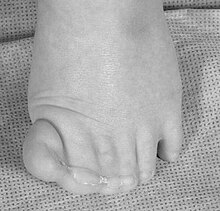Greig cephalopolysyndactyly syndrome
This article needs additional citations for verification. (February 2008) |
| Greig cephalopolysyndactyly syndrome |
|---|
Greig cephalopolysyndactyly syndrome is a disorder that affects development of the limbs, head, and face. The features of this syndrome are highly variable, ranging from very mild to severe. People with this condition typically have one or more extra fingers or toes (polydactyly) or an abnormally wide thumb or big toe (hallux).
The skin between the fingers and toes may be fused (cutaneous syndactyly). This disorder is also characterized by widely spaced eyes (ocular hypertelorism), an abnormally large head size (macrocephaly), and a high, prominent forehead. Rarely, affected individuals may have more serious medical problems including seizures, mental retardation, and developmental delay.
Pathophysiology



Greig cephalopolysyndactyly syndrome is a chromosomal condition related to chromosome 7. Mutations in the GLI3 gene cause Greig cephalopolysyndactyly syndrome. The GLI3 gene provides instructions for making a protein that controls gene expression, which is a process that regulates whether genes are turned on or off in particular cells. By interacting with certain genes at specific times during development, the GLI3 protein plays a role in the normal shaping (patterning) of many organs and tissues before birth.
Different genetic changes involving the Gli3 gene can cause Greig cephalopolysyndactyly syndrome. In some cases, the condition results from a chromosomal abnormality, such as a large deletion or translocation of genetic material, in the region of chromosome 7 that contains the GLI3 gene. In other cases, a mutation in the GLI3 gene itself is responsible for the disorder. Each of these genetic changes prevents one copy of the gene in each cell from producing any functional protein. It remains unclear how a reduced amount of this protein disrupts early development and causes the characteristic features of Greig cephalopolysyndactyly syndrome.
This condition is inherited in an autosomal dominant pattern, which means the defective gene is located on an autosome, and only one copy of the defective GLI3 gene is sufficient to cause the disorder. In cases of dominant inheritance, an affected person inherits the genetic mutation or chromosomal abnormality from one affected parent.
Rare instances of this disorder are sporadic, and occur in people with no history of the condition in their family.
Eponym
The condition is named for David Middleton Greig FRSE.[1]
References
External links
- Greig cephalopolysyndactyly syndrome at NLM Genetics Home Reference
- GeneReview/NIH/UW entry on Greig Cephalopolysyndactyly Syndrome
